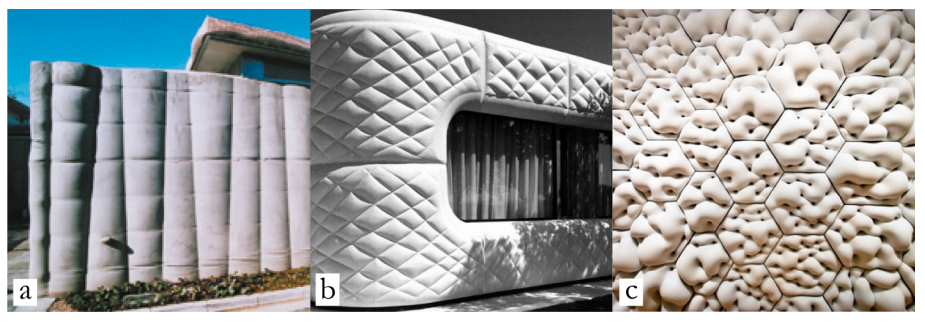In the recently published ‘Tailored flexibility: reinforcing concrete fabric formwork with 3D printed plastics,’ authors Jon Engholt and Dave Pigram create a construction system integrating robotics and new techniques. The study focused on concrete because of its flexibility, while pointing out that this material is still somewhat limited—thus explaining why flat forms are still so often used routinely while curved structures are avoided. Flexible materials offer great potential for improving the structure of buildings, however.
3D printing, accompanied by robotics capable of plastic extrusion, can outweigh some of the previous challenges often connected to fabric framework. This also includes benefits like added options for forms and surface qualities, with plastic working to reinforce material and performing as a design medium too. Concrete is usually cast in molds, and curves are typically considered hard to achieve, leaving users to turn to materials like timber; however, wood and milled foam generally result in significant amounts of waste.

a. Wall by Kenzo Unno (Copyright: Kenzo Unno) b. Facade by Miguel Fisac
(Copyright: Miguel Fisac Foundation) c. P_wall by Matsys Design (Copyright: Andrew Kudless).
“Fabric formwork addresses some of these issues as a sustainable alternative to traditional formwork, utilised as both a means to reduce material use in formwork and a means to realise more complex and structurally efficient forms,” state Engholt and Pigram, also pointing out that there have been strides made with CNC 3D knitting, although the techniques are still somewhat limited.
For this research, they performed numerous tests, including matching extrusion and fabric material, tuning the print technique, and then dealing with the composition of concrete. They also detoured to compare 3D plastic printing to that of fabric frameworks and ‘the logic of tensile shuttering.’ The set up for this experiment consisted of a large-scale plastic extruder mounted on a KUKA 7-axis robotic arm, using ABS. The authors tested numerous fabrics:
“The textural quality and resolution of the fabric presented one variable that suggests perfect conditions for mechanical adhesion of extrusion material by partly penetrating the fabric,” explained the researchers. “The coarse resolution of both tulle fabric and geotextile weaves suggested a sufficiently uneven surface for adhesion.
“However, due to the material composition of these fabrics (tulle made of polyester and geotextile of polypropylene), the chemical bonding properties appeared to be the primary means of adhesion, preventing the extrusion material to bond with the surfaces.”
During the cooling process, the researchers discovered that ABS shrank while cooling, causing warping, and transformation in fit. The problem continued further as printing went on, with the plastic becoming ‘irregularly warped.’ As they experimented with PLA, the researchers found that they were able to get shrinkage under control, but then experienced decreased tensile strength and even brittleness.
“These issues with material strength and shuttering flexibility suggest further studies into printing media with different mechanical properties,” stated the researchers.
Initial casting evaluated shuttering of fabric and plastic extrusion, along with the weight of the concrete. The authors stated that the toolpath generation approach was abandoned; however, they did note that the discrete part toolpath generation permitted structural considerations to become part of the process.
“The limited strength of the plastic thus introduced two resolutions of support: An overall distribution of clamps and a finer-resolution mesh of printed material – both of which had a finite limit in scale to prevent collapse. Printing bespoke ‘pinch-mould’ details to block out the shuttering and locally create openings through the casts mainly relied on the rigidity of the two clamped sides rather than adhesion and tensile strength – and thus proved efficient.”
Because the plastic was so limited, the researchers found two new ‘resolutions of support’ in the distribution of clamps—plus, finer resolution mesh of printed material. Overall, they discovered ‘a vast space of possibilities’ with a small number of variables.
“The process thus affords a high complexity in material manifestation through a low complexity in formal operations and design. Since the flexibility of the tailored shuttering allows it to adapt and attach to non-flat geometries, the process suggests a combination with bespoke bent rebar reinforcement that might offer enough rigidity to avoid any additional formwork components,” concluded the authors.
3D printing encompasses numerous elements, beginning with hardware; however, the study of materials and resulting form is critical—and as the choices continue to expand, users can experiment widely, from the use of different thermoplastics to metal composites, and other alternative materials. What do you think of this news? Let us know your thoughts! Join the discussion of this and other 3D printing topics at 3DPrintBoard.com.
[Source / Images: ‘Tailored Flexibility: Reinforcing concrete fabric formwork with 3D printed plastics’]Subscribe to Our Email Newsletter
Stay up-to-date on all the latest news from the 3D printing industry and receive information and offers from third party vendors.
You May Also Like
Gorilla Sports GE’s First 3D Printed Titanium Cast
How do you help a gorilla with a broken arm? Sounds like the start of a bad joke a zookeeper might tell, but it’s an actual dilemma recently faced by...
Nylon 3D Printed Parts Made More Functional with Coatings & Colors
Parts 3D printed from polyamide (PA, Nylon) 12 using powder bed fusion (PBF) are a mainstay in the additive manufacturing (AM) industry. While post-finishing processes have improved the porosity of...
$25M to Back Sintavia’s Largest Expansion of Metal 3D Printing Capacity Since 2019
Sintavia, the digital manufacturing company specializing in mission-critical parts for strategic sectors, announced a $25 million investment to increase its production capacity, the largest expansion to its operations since 2019....
Velo3D Initiates Public Offering in a Bid to Strengthen Financial Foundations and Drive Future Growth
Velo3D (NYSE: VLD) has been among a number of publicly traded 3D printing firms that have attempted to weather the current macroeconomic climate. After posting a challenging financial report for 2023,...



































